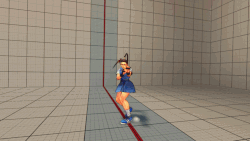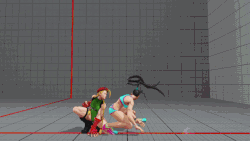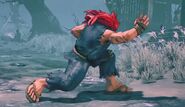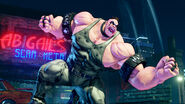
The hitboxes of Dart Shot, an overhead attack, in the Street Fighter IV series.
An overhead attack (or mid-level attack in Japanese terms) is a type of attack that appears in the Street Fighter games.
Description[]
Overhead attacks bypass a low guard by attacking downwards from a grounded position, while standing overhead (hence the name). Overhead attacks can be blocked high, however, and this necessity to block an attack at the correct height creates a "guessing game", where a defender must attempt to guess where the next attack is coming from, and an attacker must guess which way the opponent will block.
In Japanese speaking circles and in 3D-fighting games however, these types of attacks that must be blocked standing are always called "mid-level" attacks instead of overhead; mid attacks in most overseas speaking circles for many 2D-fighting games are often reserved for attacks that can be blocked either high or low, though 3D-fighting games often refer to these as unique/special-mids instead.
Overhead-mid-level attacks can come in the form of special attacks or unique attacks. Not every fighter character possesses an overhead unique attack, nor does every fighter possess an overhead special attack; however, most characters possess at least one or the other, and every character can also perform a jumping attack, which will also bypass a low block.
Overheads tend to be modified on a game-per-game basis to better work with a unique mechanic of said game. In Street Fighter × Tekken some overheads were modified to better work with the Switch Cancel mechanics of said game while in Street Fighter V some can work with the V-Trigger mechanic. Sometimes characters have purpose built overheads such as Dhalsim in Street Fighter IV with his overhead only being practical for Yoga Catastrophe mix-ups.
Street Fighter III series[]
| Street Fighter III Street Fighter III: 2nd Impact |
|
|---|---|
| Street Fighter III: Third Strike |
Characters in the Street Fighter III series also have a "universal" overhead, also known as a "leap attack". It is executed by pressing down twice and then pressing any punch or kick button simultaneously. In 3rd Strike, it is performed by pressing medium punch and medium kick simultaneously. These leap attacks can travel over many low-aiming moves (often dubbed as attribute-crushing, e.g. high/low-crushing), and are useful for poking an opponent out of "turtling", or defending constantly while ducking. Some characters use a preset normal attack for their animation (for example, Ryu uses his jumping medium punch).
This type of leaping overhead is also a staple for other characters in other fighting games; however, some usages of this type often vary in that they may possess more unique hitboxes and jump-arcs; some may not even be overheads at all. There are also very few other fighting games with a universal overhead for all characters in this scheme, only they may not involve a hop into an attack. Regardless, the most common theme of these kinds of hop attacks, overhead or not, is to crush/bypass low-hitting attacks of many kinds.
Street Fighter IV series[]

An overhead in IV
Universal overheads were removed in IV and by extension spin-off game Street Fighter X Tekken, (although Dudley still has his leap attack as a unique attack, executed by pressing down twice and then medium kick). Whether a character has an overhead is a character by character basis.
Overheads are overall slower in these games thanks to the removal of the Parry mechanic. Most overheads are not a part of combos with some exceptions (e.g. Hammer Kick). Overheads tend to make very little to no sound on startup to make them harder to react to.
Street Fighter V series[]
Most overheads have fairly similar attributes, such as a slow startup at around 22 frames, very rarely leading into a combo, and being at least -7 on block. Certain moves such as Mercury Shard and Chopping Assault are throw-invincible, letting them be used as unorthodox reads. Overheads with longer than average startup make up for it with higher reward, such as Menat's Divine Retribution being special-cancellable into her Soul Sphere. Counter Hit overheads, while rare, can lead to a combo on hit. Some overheads are not cancelable but through linking can be followed up on even without counter hits.
Street Fighter 6[]
Overheads overall are safe on block, though still somewhat slow on startup. Using a Drive Rush, overheads gain considerable distance along with an extra four frames of advantage, making them both positive on block and comboable afterwards. However, Drive Impact and Drive Parry can lead to some devastating punishes if the overheads are anticipated, making careful timing vital to optimal usage.
Instant Air Overheads[]

Ibuki setting up an instant air overhead against Cammy.
Since the IV series, it takes the game some frames to officially transition a defending character's hurtbox between standing and crouching. For a few frames after a character crouches they still have their standing hurtbox, this allows some characters such as Ibuki with her Jumping Light Kick to perform a "Instant Air Overhead", taking advantage of these transitional frames to strike a crouching character. This tactic is usually refereed to as "fuzzy guard". Immediately using a crouching attack when crouching will bypass the fuzzy guard stage and immediately count the user as crouching though care should be taken to only do this against attacks that only hit standing opponents as since the fuzzy guard bypass requires an action the ability to block is taken away from the defender until the attack completes.
Instant Air overheads should only be used as finishers, as even on hit they are very negative afterwards in terms of Frame Data. If the opponent is within the KO range of their instant air overhead this tactic becomes very deadly, as instant air overheads usually have around 6-8 frames of startup. This is much faster than regular overheads and the startup can be masked with a tricky approach and setup before the attack comes out.










